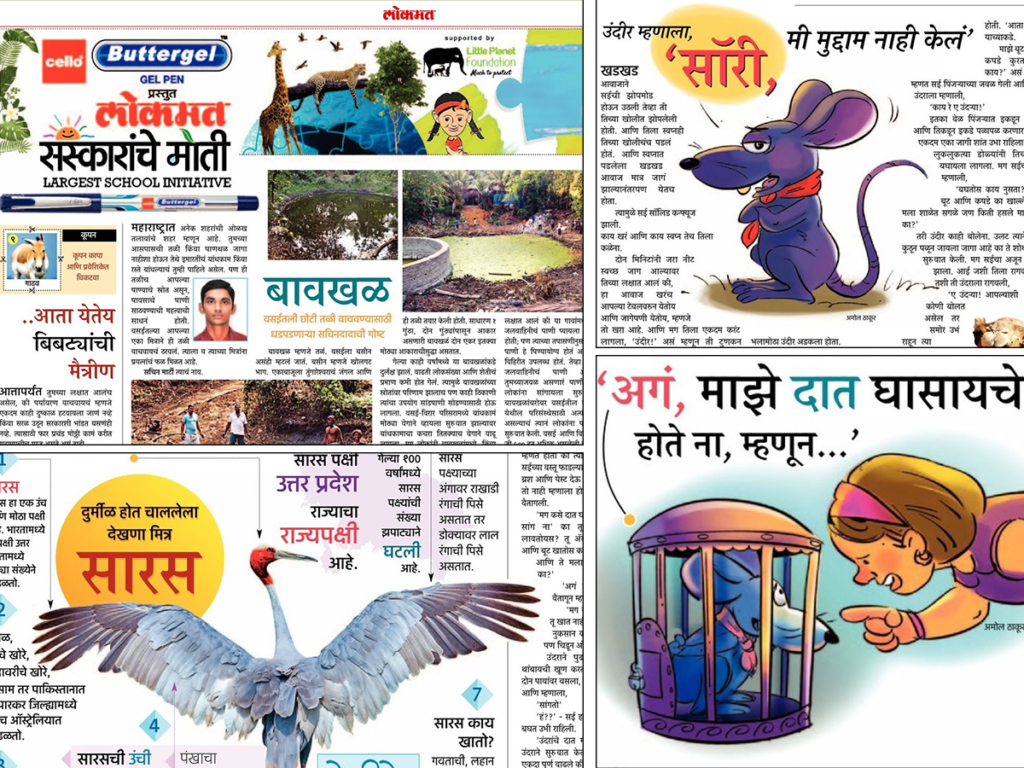Project Sansakarache Moti

Sanskarache Moti is Lokmat Groups social initiative which targets 1,150 schools involving over 2 million students from all across Maharashtra & Goa. Lokmat is India’s 2nd largest Regional newspaper with a readership of approximately 7.2 million readers daily. This year “Little Planet Foundation” (LPF) an Initiative by Aryaman Darda has collaborated with Lokmat Sanskarache Moti (LSM) as a knowledge partner to spread the awareness on the importance of Nature, Wildlife and our Environment in the rural & urban areas. In this page, we are sharing important information on wildlife and environment-related news, features and interviews from across the globe. We have also started introducing Wildlife enthusiasts as an inspiration to students. LPF (Little Planet Foundation) is also responding to all the letters, questions or any kind of queries of various students.
What is Sanskarache Moti
When we think about things like environment, pollution and global warming, the first thought that crosses our mind is that there is so much to protect and so little time to do it. But the kids never get proper information; nobody includes them in the discussion about climate change. This is just plain injustice as they are the ones who are really going to face the consequences of the mistakes that we make today and they are the ones who are going to be able to avoid this global catastrophe called climate change. But how will they do it?
Well… When you know how a child’s brain works, you feel sure that they will come up with some mind blowing idea. But to do that, they must be informed in the first place. And this is where LPF (Little Planet Foundation) came into picture. LPF decided to partner with Lokmat Newspapers, the leading newspaper daily in Maharashtra as a knowledge partner for its initiative Lokmat Sanskarache Moti (LSM).
LSM was a 100 days initiative where one page dedicated to environment was published daily in Lokmat. This page was specially designed for children between 4th to 10th standard. The content was generated so as to be informative but not preachy. This initiative got a grand response as thousands of students from hundreds of schools read this page throughout Maharashtra. They also wrote a lot of emails and letters and LPF tried it’s best to answer all their questions. An essay writing competition was held at various centers throughout Maharashtra. Thousands of students participated in it.
Reading these essays, letters and emails was the most enriching experience. And it will be equally so for the readers of LPF to read in details about the content of LSM. But more about it soon…
Why did we do Sanskaranche Moti
The basic thought behind doing Sanskaranche Moti was NOT to preach, but to give a platform to students from 4th to 10th standard, to give them information, to discuss ideas, to understand their queries about protecting our nature.
And as expected, LPF was showered with letters and emails from even the most remote villages of Maharashtra. All our readers were bursting with questions and ideas. They wanted to ask the former and share the later. And it was a trilling experience to go through all that correspondence. It warmed our heart to see so many young minds already at work for saving our planet.
Many had a well thought out plan to do their bit to at least slow down climate change. Some have stopped using plastic as much as possible, some have planted trees, some are trying use renewable energy and almost all were passionate about saving water.
But at the same time they had their share of genuine questions. LPF did it’s best to answer all these questions and to encourage all the possible or even probable ideas. We are sure that this initiative has sparked change in quite a few minds. So, if you now visit a home and are offered only half a glass of water instead of a full one, do remember to ask if they have reader of Sanskaranche Moti in the house!
Why? What? When? How?
Why, What, When and How are the four words that are working overtime in a young mind. These are the words that encourage kids to find answers and seek solutions. But finding answers is easier said than done. Especially if you have questions that are not in your curriculum, or if finding those answers are not going to increase your marks, the enthusiasm of elders rapidly depletes, leaving the young ones on their own to search for information.
But kids’ curiosity is genuine and their willpower is strong. When they have a question about nature, they tend to find the answer somehow. But they very rarely stop there… If they identify a problem, find a solution and are convinced to it, they usually see the matter through and make sure that the solution is implemented by them and by everyone around them.
Kids will request elders, coax them to change their habits and badger them with questions if the elders don’t comply with the kids’ idea of eco-friendly behavior. This is the strength of having a young mind. It is open and energetic. All it needs to bring about a change is the correct information. And that is what we tried to do through Sanskaranche Moti by dedicating a column to answer the 4 Ws… Why? What? When? How?